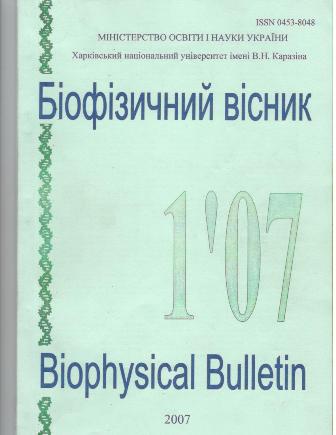Morphological response of erythrocytes on changes of electrolyte content of the medium. II. Effect of anion transport inhibitors
Abstract
The effect of anion transport inhibitors DIDS, SITS and DNDS on dynamic of erythrocyte shape changes in sucrose media with low content of chloride ions was studied. It was shown that DIDS and SITS acted similarly though the several times more concentration of DIDS was required to produce the same effect. Both agents affect typical three phase shape response of cells in concentration-dependent manner initially eliminating second and third phases and finally stabilizing the first sphere-like phase. The latter is characterized by low value of shape index which is formed immediately after cell transfer into nonelectrolyte media in the presence of inhibitors. Microscopic analysis confirms that spherostomatocytes are formed at this stage of shape transformation. In contrast, when the same amount of inhibitor was added to the media in 150 s after cell transfer there was an increase in shape index which reflected cell flattening. The effect of DNDS was different from that of DIDS and SITS. DNDS did not affect cell shape when it was added in 150 s after cell transfer. If DNDS was initially present in the media the duration of all phases in shape response sequence is increased with the increasing inhibitor concentration. The data obtained show that morphological transformation of cells in nonelectrolyte media depends significantly not on only the functional state of the system of anion transport but also on detailed chemical nature of inhibitor.
Downloads
References
Bennekou P, Barksman n TL, Kristensen BI, Jensen LR, Christophersen P. Pharmacology of the human red cell voltage-dependent cation channel. Part II : inactivation and blocking. Blood Cells Mol.Dis. 2004:33(3):356-61.
Glaser R. Does the transmembrane potential (Deltapsi) or the intracellular pH (pHi) control the shape of human erythrocytes?. Biophys.J. 1998;75(1):569-70.
Muller P, Herrmann A, Glaser R. Further evidence for a membrane potential-dependent shape transformation of the human erythrocyte membrane. Biosci.Rep. 1986:6(11):999-1006.
Hartmann J, Glaser R. The influence of chlorpromazine on the potential-induced shape change of human erythrocyte. Biosci.Rep. 1991;11(4):213-21.
Sambasivarao D, Rao NM, Sitaramam V. Anomalous permeability and stability characteristics of erythrocytes in non-electrolyte media. Biochim.Biophys.Acta. 1986;857(1):48-60.
Betz T, Bakowsky U, Muller MR, Lehr CM, Bernhardt I. Conformational change of membrane proteins leads to shape changes of red blood cells. Bioelectrochemistry. 2007;70:122-126.
Kaestner L, Christophersen P, Bernhardt I, Bennekou P. The non-selective voltage-activated cation channel in the human red blood cell membrane: reconciliation between two conflicting reports and further characterisation. Bioelectrochemistry. 2000;52(2):117-25.
Barksmann TL, Kristensen BI, Christophersen P, Bennekou P. Pharmacology of the human red cell voltage- dependent cation channel; Part I. Activation by clotrimazole and analogues. Blood Cells Mol.Dis. 2004;32(3):384-8.
Bennekou P, Kristensen BI, Christophersen P. The human red cell voltage-regulated cation channel. The interplay with the chloride conductance, the Ca(2+)-activated K(+) channel and the Ca(2+) pump J.Membr.Biol. 2003;195(1):1-8.
Blank ME, Hoefner DM, Diedrich DF. Morphology and volume alterations of human erythrocytes caused by the anion trasporter inhibitors, DIDS and p-azidobenzylphlorizin. Biochim.Biophys.Acta. 1994;1192(2):223-33.
Wong P. Mechanism of control of erythrocyte shape: a possible relationship to band 3. J.TheorBiol. 1994;171(2):197-205
Gimsa J. A possible molecular mechanism governing human erythrocyte shape Biophys.J 1998;75(1):568-9.
Sheetz MP, Alhanaty E. Bilayer sensor model of erythrocyte shape control. Ann.N.Y.Acad.Sci. 1983;416:58-65.
Jones GS, Knauf PA. Mechanism of the increase in cation permeability of human erythrocytes in low-chloride media. Involvement of the anion transport protein capnophorin. J.Gen.Physiol 1985:86(5):721-38.
Zeidler RB, Kim HD. Effects of low electrolyte media on salt loss and hemolysis of mammalian red blood cells. J. Cell Physiol. 1979;100(3):551-61.
Kummerow D, Hamann J, Browning JA, Wilkins R, Ellory JC, Bernhardt I. Variations of intracellular pH in human erythrocytes via K(+)(Na(+))/H(+)exchange under low ionic strength conditions. J.Membr.Biol. 2000;176(3):207-16.
Rudenko SV, Krouf DzhKh, Tablin F. Izmenenie formy eritrotcitov v zavisimosti ot vremeni. Biokhimiia. 1998;63(12):46-55. (in Russian)
Rudenko SV. Agregatciia eritrotcitov kak model agregatci trombotcitov. Biologicheskie membrany. 2006;23(1):61-8. (in Russian)
Eriksson LE. On the shape of human red blood cells interacting with flat artificial surfaces—the ‘glass effect’. Biochim.Biophys.Acta. 1990;1036(3):193-201.
Tachev KD, Danov KD, Kralchevsky PA. On the mechanism of stomatocyte-echinocyte transformations of red blood cells: experiment and theoretical model. Colloids. Surf.B.Biointerfaces. 2004;34(2):123-40.
Svetina S, Kuzman D, Waugh RE, Ziherl P, Zeks B. The cooperative role of membrane skeleton and bilayer in the mechanical behavior of red blood cells. Bioelectrochemistry. 2004;62(2):107-13.
Deuticke B. Transformation and restoration of biconcave shape of human erythrocytes induced by amphiphilic agents and changes of ionic environment. Biochim. Biophys. Acta. 1968;163:494-500.
Schwarz S, Haest CW, Deuticke B. Extensive electroporation abolishes experimentally induced shape transformations of erythrocytes: a consequence of phospholipid symmetrization? Biochim. Biophys. Acta. 1999:1421(2):361-79.
Reinhart WH, Chien S. Echinocyte-stomatocyte transformation and shape control of human red blood cells: morphological aspects. Am.J.Hematol. 1987:24(1):1-14.
Nwafor A. Coakley WT. Charge-independent effects of drugs on erythrocyte morphology. Biochem. Pharmacol. 1985;35(6):953-7.
Nwafor A, Coakley WT. Drug-induced shape change in erythrocytes correlates with membrane potential change and is independent of glycocalyx charge. Biochem.Pharmacol. 1985:34(18):3329-36.
Chen JY, Huestis WH. Role of membrane lipid distribution in chlorpromazine-induced shape change of human erythrocytes. Biochim.Biophys.Acta. 1997,1323(2)299-309.
Authors who publish with this journal agree to the following terms:
- Authors retain copyright and grant the journal right of first publication with the work simultaneously licensed under a Creative Commons Attribution License that allows others to share the work with an acknowledgement of the work's authorship and initial publication in this journal.
- Authors are able to enter into separate, additional contractual arrangements for the non-exclusive distribution of the journal's published version of the work (e.g., post it to an institutional repository or publish it in a book), with an acknowledgement of its initial publication in this journal.
- Authors are permitted and encouraged to post their work online (e.g., in institutional repositories or on their website) prior to and during the submission process, as it can lead to productive exchanges, as well as earlier and greater citation of published work (See The Effect of Open Access).





